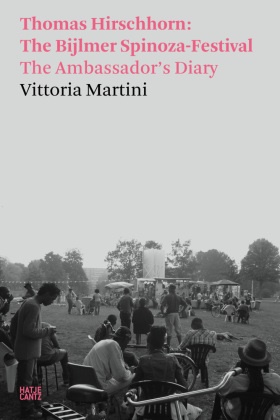Read more
The Bijlmer Spinoza-Festival is an artwork, a sculpture, created by Swiss artist Thomas Hirschhorn in a peripheral borough of Amsterdam's south-east known as the Bijlmer in 2009. This book recounts the event through the eyes of its "Ambassador", art historian Vittoria Martini, who was invited by the artist to be an eyewitness to the existence of this "precarious" work. A term Hirschhorn sees as positive and creative: a means of asserting the importance of the moment and of the place, of asserting the Here and Now to touch eternity and universality. Appreciating the art historian's presence as a central element of his sculpture, Hirschhorn consciously challenged the certainties of the profession by empowering and activating the role, thus leading Martini to find a new working methodology that she calls "precarious art history". Accompanying the readers through her experience of the physical existence of The Bijlmer Spinoza-Festival, Martini's commentary leads to the profound understanding of how a work that no longer exists physically, can live on in the mind- elsewhere, at some other time-because in the meantime it has become universal.
Paris-based artist THOMAS HIRSCHHORN (*1957, Bern) is best known for his sculptures in public space-monuments, kiosks, and altars. Questioning the autonomy, the authorship, and resistance of a work of art, he asserts the power of art to touch and transform the other. He represented Switzerland at the 54th Venice Biennale in 2011 and received numerous awards, including the Prix Marcel Duchamp and the Joseph Beuys Stiftung Prize.
VITTORIA MARTINI (*1975, Kinshasa) is an independent art historian living in Italy. She has a doctorate from Università Ca' Foscari/Università Iuav di Venezia. Since 2013 she teaches History of exhibitions and curatorial practices and holds the Art Writing workshop at CAMPO - Program of curatorial studies and practices established by the Fondazione Sandretto Re Rebaudengo (Turin, Italy). Her research focuses mainly on the institutional structures that produce exhibitions.
List of contents
CoverInhaltNote to the ReaderIntroductionThomas Hirschhorn, The Bijlmer Spinoza-Festival, 2009Thomas Hirschhorn, Presence and Production, 2009Thomas Hirschhorn, Assignment, 2009May 2 - May 17Marcus Steinweg, Spinoza Theater, 2009May 19 - May 20What Does It Mean to Be the Ambassador, March 19, 2009May 24Letter to Lisa Lee, First Exchange on The Bijlmer Spinoza-Festival, May 26, 2009May 26Letter from Lisa Lee, May 26, 2009May 27To Be an Art Historian at The Bijlmer Spinoza-Festival, May 29, 2009May 30 - June 9Letter to Mignon Nixon, About Sculpture, June 6, 2009June 16Letter to Claire Bishop, About the Ambassador, June 17, 2009Thomas Hirschhorn, Toward "Precarious Theater", June 18, 2009Letter from Mignon Nixon, June 19, 2009Letter from Claire Bishop, June 19, 2009Letter to Claire Bishop, Thanks for Your Thoughts, June 21, 2009June 22 - June 28Thomas Hirschhorn, Faith, June 2009ColophonBackcover
About the author
THOMAS HIRSCHHORN (*1957, Bern) lebt und arbeitet in Paris. Seine Monumente, Altäre und Kioske finden international Beachtung und sind mehrfach ausgezeichnet. Er ist unter anderem Gewinner des Prix Marcel Duchamp, des Joseph Beuys-Preises Basel sowie des Grand Prix Kunst/Prix Meret Oppenheimer des Schweizer Bundesamts für Kultur.THOMAS HIRSCHHORN (*1957, Bern) lebt und arbeitet in Paris. Seine Monumente, Altäre und Kioske finden international Beachtung und sind mehrfach ausgezeichnet. Er ist unter anderem Gewinner des Prix Marcel Duchamp, des Joseph Beuys-Preises Basel sowie des Grand Prix Kunst/Prix Meret Oppenheimer des Schweizer Bundesamts für Kultur.
Summary
The Bijlmer Spinoza-Festival is an artwork, a sculpture, created by Swiss artist Thomas Hirschhorn in a peripheral borough of Amsterdam’s south-east known as the Bijlmer in 2009. This book recounts the event through the eyes of its “Ambassador”, art historian Vittoria Martini, who was invited by the artist to be an eyewitness to the existence of this “precarious” work. A term Hirschhorn sees as positive and creative: a means of asserting the importance of the moment and of the place, of asserting the Here and Now to touch eternity and universality. Appreciating the art historian’s presence as a central element of his sculpture, Hirschhorn consciously challenged the certainties of the profession by empowering and activating the role, thus leading Martini to find a new working methodology that she calls “precarious art history”. Accompanying the readers through her experience of the physical existence of The Bijlmer Spinoza-Festival, Martini’s commentary leads to the profound understanding of how a work that no longer exists physically, can live on in the mind— elsewhere, at some other time—because in the meantime it has become universal.
Paris-based artist THOMAS HIRSCHHORN (*1957, Bern) is best known for his sculptures in public space—monuments, kiosks, and altars. Questioning the autonomy, the authorship, and resistance of a work of art, he asserts the power of art to touch and transform the other. He represented Switzerland at the 54th Venice Biennale in 2011 and received numerous awards, including the Prix Marcel Duchamp and the Joseph Beuys Stiftung Prize.
VITTORIA MARTINI (*1975, Kinshasa) is an independent art historian living in Italy. She has a doctorate from Università Ca’ Foscari/Università Iuav di Venezia. Since 2013 she teaches History of exhibitions and curatorial practices and holds the Art Writing workshop at CAMPO – Program of curatorial studies and practices established by the Fondazione Sandretto Re Rebaudengo (Turin, Italy). Her research focuses mainly on the institutional structures that produce exhibitions.

